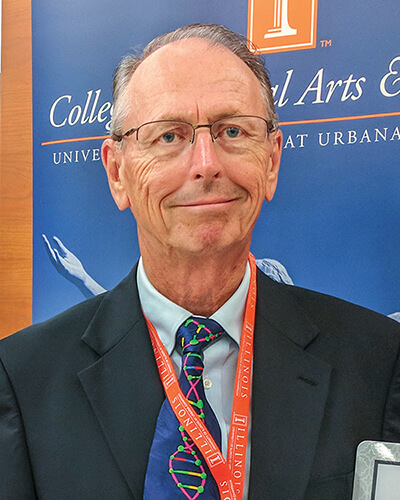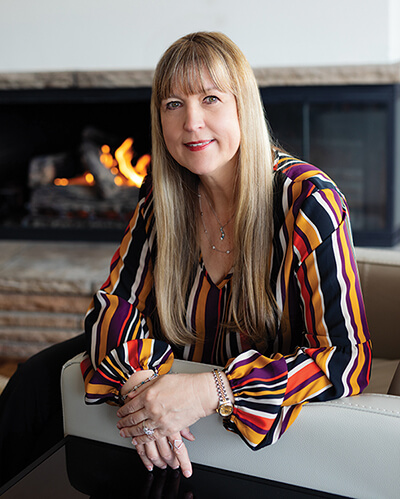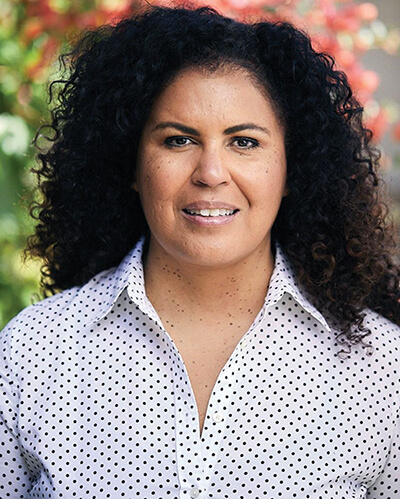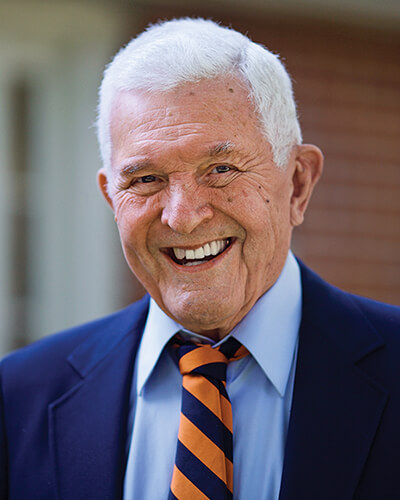2020 University of Illinois Alumni Award Recipients
ALUMNI ACHIEVEMENT AWARD
Chemical Catalyst
Chemical engineer Joe Glas took action against ozone depletion, receiving kudos from the EPA for developing an environmentally friendly Freon replacement
When Joe Glas, MS ’62 LAS, PHD ’65 LAS, was put in charge of the Freon division of chemical company DuPont in 1985, he thought the controversy surrounding the refrigerant—namely, the theory that Freon contributed to ozone depletion—was over.
Seven years had passed since the U.S. government banned the use of chlorofluorocarbons (CFCs) such as Freon in aerosols. Although environmental groups continued to critique the use of CFCs in refrigerators and air conditioners, it had become such a nonissue that in Glas’ initial briefings after his promotion to director, the subject never came up.
“Frankly, I pretty much overlooked the debate,” Glas says.
That changed a few months into his tenure, however. One of his lieutenants stopped by his office with a warning. “He said, ‘I think you should know, this ozone issue is rearing its head again,’” Glas recalls.
Scientists had discovered a hole in the ozone layer above the Antarctic, prompting a fresh wave of criticism of Freon and other CFCs. DuPont CEO Richard Heckert, MA ’47 LAS, PHD ’49 LAS, pointed to promises DuPont’s leaders had made in the 1970s that the company would abandon CFCs if it found conclusive scientific evidence that the products were harmful. In early 1988, Heckert said that promise remained in effect, but no such evidence had come to light.
Glas and his team were reviewing a new study that convinced them otherwise; it provided evidence that CFCs were contributing to ozone depletion, causing Glas’ team to rethink its own internal modeling. Glas took the evidence to the DuPont board, and the company quickly made good on its promise to ban CFCs.
Glas then jumped into his next challenge: quickly developing a Freon replacement, an enormous undertaking on several fronts. First, while Freon was bad for the environment, it was much healthier for people than the refrigerants it had replaced half a century earlier, in the sense that it wasn’t flammable and could be inhaled without ill effects. Glas knew the replacement couldn’t take a step backward in that regard. Second, the effort required mass coordination among DuPont, appliance makers whose products used Freon, and even the U.S. military, which used Freon to clean sensitive electronics.
Glas was given a blank check to fund the effort, and his team raced to make it happen. DuPont had begun developing Freon alternatives years earlier, so Glas’ project centered on testing and getting those replacements market-ready. In less than a year, Glas reappeared before the board to propose a new commercial plant that would manufacture DuPont’s Freon substitute, called Suva.
The board’s response? “They said, ‘What took you so long?’” Glas recalls.
Glas was ultimately promoted to vice president and general manager, and retired in 1999. He spent 34 years at DuPont, joining the company in 1964 as he was wrapping up his Ph.D. in chemical engineering at Illinois. His DuPont tenure included stints working on brands such as Mylar, Cellophane and Remington Arms. The U.S. government awarded DuPont its National Medal of Technology for its leadership in the transition away from CFCs, and the U.S. Environmental Protection Agency recognized DuPont with its Stratospheric Ozone Protection Award.
Glas is now retired and lives with his wife Donna near Jacksonville, Fla. They endowed a scholarship at Illinois in memory of one of Glas’ mentors: the Dr. Joseph and Donna Glas Scholarship in Memory of Professor James Westwater. (Westwater was a Class of ’47 graduate of the University.) Ever loyal to his Alma Mater, Glas chaired the U of I Dept. of Chemical and Biomolecular Engineering’s resource development committee in the early 1990s and has served on its external advisory committee.
Recognition is nice, but the most important result of Glas’ leadership is the effect it has had on the environment. In 2018, the National Aeronautics and Space Administration published a study based on satellite imagery that offered the first direct proof that the ozone layer is healing in response to the elimination of CFCs.—Steve Hendershot
ALUMNI ACHIEVEMENT AWARD
Corporate Communicator
Angela Sinickas Shiromani improves employee relations by working with top companies to evaluate and address internal communication effectiveness
It’s not hard to imagine, over the past four decades, more than one corporate CEO, when facing a challenge communicating with employees, has turned to the company’s human resources director and said, “Get me Angela Sinickas Shiromani!”
That’s because Sinickas Shiromani, ’75 MEDIA—a trailblazer in the field of corporate communications—has established an international reputation as an expert who can improve employee relations by evaluating the effectiveness of a company’s communications efforts, recommending changes in approach and providing appropriate training.
“I help businesses get better financial results by measurably improving communication with employees and other stakeholders,” Sinickas Shiromani says. But that explanation barely begins to cover the depth and breadth of her work. She has provided consulting services to companies in 32 countries, including more than a third of the businesses on the 2019 Forbes list of 100 largest global companies. And her work has earned her prestigious Gold Quill awards from the International Association of Business Communicators on 21 occasions.
The daughter of Lithuanian immigrants, Sinickas Shiromani says she was focused at an early age, skipping a grade in elementary school, entering the U of I when she was 17 and completing her degree in three years. She began her career working for the UIC College of Medicice editing its Medical Center Alumni News. In 1979, she left to become editor of the employee magazine at the Chicago Tribune where she had to convince a numbers-oriented CEO that there was value in communicating with employees.
To get the data she needed, Sinickas Shiromani turned to lessons she had learned in U of I classes on advertising research strategies. She treated the paper’s employees as customers, using interviews and surveys to produce measurable results. “My first job at the U of I involved communicating about science,” she says. “After that, I became scientific about communication.”
Not all of Sinickas Shiromani’s decisions have been based on cold, hard facts. In 1984, she moved to California to be with her husband, Sarvottam “Sam” Shiromani, ’84 uic. Once there, she quickly made a name for herself as a consultant before opening her own business in 2000.
“Angela is a pioneer in the industry,” says David Murray, founder and president of the Professional Speechwriters Association, and editor of Sinickas Shiromani’s first book, How to Measure Your Communication Programs, published in 1994. “She transformed employee communication from a corporate gesture into a purposeful pursuit. And she did so with equal parts shrewd scientific methods and her own immeasurable conviction.”
That book is in its third edition; in 2017, Sinickas Shiromani published a follow-up, The Ultimate Guide to Measuring Internal Communications. She also has written more than 150 trade journal articles. “It brings me satisfaction that I’ve been able to impact the lives of so many employees and the people whose job it is to communicate with them,” she says. “I think I’ve been able to elevate the value of what they do.”
Having been displaced by WWII, Sinickas Shiromani’s parents arrived in Chicago in the early 1950s, her father finding work as a tool and die setter and her mother as a secretary. Their experience made a deep and lasting impression on her, she says, instilling a sense of pride about her ethnic heritage. Fluent in Lithuanian, Sinickas Shiromani has done extensive volunteer work in Lithuania, imparting her expertise in business communications through speaking engagements at conferences. She has done guest teaching at the oldest university in the Baltic States, Vilnius University, and the Baltics’ ISM University of Management and Economics.
“I wanted to give back to a country and culture that shaped me in so many ways,” she says. In recognition of her efforts, the president of Lithuania presented Sinickas Shiromani with the Global Lithuanian Leaders Award for Knowledge Sharing in 2014.
Sinickas Shiromani is “beyond tickled to death” to be honored with the Alumni Achievement award. “When I walked through the Illini Union as a student, I would check out the portraits of previous winners and imagine what I would need to achieve in my career to have my picture up there with them,” she says. “Now I know.”—Paul Engleman
YOUNG ALUMNI AWARD
Research Risk-taker
Chemical physicist Markita Landry’s carbon nanotubes are small enough to breach impenetrable barriers, and that could be big news in the fight against COVID-19
Submitting your first paper for publication is a nerve-wracking rite of passage for any Ph.D. student. While pursuing her doctorate in chemical physics at Illinois with U of I Professor of Physics and Biophysics Yann Chemla, Markita Landry, PHD ’12 LAS, was floored when her inaugural paper came back from review with the following comment: “This work is perfect. Publish as is.”
“That was a really nice way to kick off my career,” Landry says. “It set a high bar for everything that came afterward.”
Landry has continually raised the bar since, earning 20 early career awards from prestigious institutions ranging from the Sloan Foundation to the Defense Advanced Research Projects Agency and the Society of Professional Hispanic Engineers. She is an ideal candidate for the inaugural University of Illinois Young Alumni Award. “It’s an honor to be recognized by the institution that made me who I am today,” she says.
Landry has forged numerous high-profile partnerships since establishing the Landry Lab in the Dept. of Chemical and Biochemical Engineering at the University of California, Berkeley in 2016. The lab’s work attracted funding from the Chan-Zuckerberg Biohub (funded by Facebook CEO Mark Zuckerberg and his wife, Priscilla Chan), which encourages awardees to take risks and pursue exciting ideas.
Landry’s risky, exciting idea is a cutting-edge tool that she developed called a single-walled carbon nanotube (SWNT). This rigid cylinder of carbon measures one nanometer in diameter by 500 nanometers in length—about 10,000 times thinner than a human hair. The nanotubes’ size and structure allow them to pass through seemingly impenetrable barriers.
For example, the Landry Lab is using SWNTs to safely breach a plant’s tough cell walls and securely ferry CRISPR (clustered regularly interspaced short palindromic repeat) gene-editing tools into plant cells for potential genetic engineering. She focuses on that work as an investigator for UC–Berkeley’s Innovative Genomics Institute, whose president, Jennifer Doudna, won the Nobel Prize in Chemistry for CRISPR.
SWNTs also emit near-infrared light, which can pass through blood, water, tissue and skin with minimal interference. That quality makes SWNTs a promising nanosensor for previously unexplored parts of the body—in particular, as a way to determine how neurotransmitters work in the brain.
With the Chan-Zuckerberg funding, Landry is developing a SWNT sensor that fluoresces in the presence of dopamine, a neurotransmitter critical in psychiatric ailments, addiction and neurodegenerative illnesses such as Huntington’s disease. “For example, we might be able to see how cocaine addiction changes brain chemistry and rewires the brain,” she explains. “In our studies of Huntington’s disease, we could see when dopamine-expressing neurons lose the ability to communicate chemically before they physically start to atrophy, allowing us to catch that disease progression earlier.”
SWNT sensors could be designed to identify a wide range of biological molecules. When the pandemic struck, the Landry Lab swiftly swung into action to develop a nanosensor to detect the protein responsible for COVID-19. Landry and her team have filed for a provisional patent and are testing their sensor on nasal fluid and saliva samples with the goal of incorporating the sensor into a rapid-detection test. “There’s certainly a sense of urgency to this work, and it is the single most collaborative project we’ve had in the lab,” she says.
Landry’s collaborations across the UC–Berkeley campus and beyond have been key to her success, especially considering that she had never conducted neurological research, let alone biological research, before launching her lab. But she was well prepared for cultivating those productive partnerships; during her Ph.D. program at Illinois, she also squeezed in a Certificate in Business Administration. “Doing the science is only half the battle,” she says. “The other half is working with students, faculty and collaborators. That requires skills different from those we learn in science textbooks. The program helped me think about how I could productively pursue my research career, manage large teams, help my students achieve their career goals and work with so many people speaking different ‘languages’ from so many different fields.”—Kristin Baird Rattini
DIVERSITY AND INCLUSION AWARD
Algorithm Activist
Safiya Noble is alerting the world to implicit bias in the inner workings of search engine optimization
Most Googlers search for something specific: song lyrics or a reliable neighborhood repair shop.
But Safiya Noble, MS ’09 IS, PHD ’12 IS, seeks to understand what isn’t shown—namely, results helpful to women of color and other marginalized populations. Her research highlights how content that actively harms them or is indifferent to their experience rises to the top of the rankings instead.
When Noble first became aware of digital injustice in graduate school, computer code was regarded as scientifically benign, certainly not something that could be prejudiced. She learned otherwise. Her dissertation became a best-selling book, Algorithms of Oppression: How Search Engines Reinforce Racism (NYU Press, 2018), and her voice joined a rising chorus of scholars who pointed out how new technologies can purposefully perpetuate past oppressions.
“Bias can, in fact, be embedded all the way down to the level of code. Algorithms can be harmful in society and have huge effects,” says Noble, now an associate professor of information studies and African American studies at the University of California, Los Angeles, and co-director—with Sarah Roberts, PHD ’14 IS—of the UCLA Center for Critical Internet Inquiry.
Noble was born and raised in Fresno, Calif., an agricultural hub. From an early age, she wondered why some neighborhoods lacked grocery stores and why undocumented farm workers were poorly treated. “Exploitation was part of the fabric of life,” she says.
During her ungraduate years at California State University, Fresno, Noble investigated these injustices, earning her degree in sociology and ethnic studies. By graduation, she understood how power inequities are endemic to the nation’s economic system, so she went to work to champion corporate social responsibility.
Her efforts moved eastward after she met her husband—a Rantoul, Ill., native—at an advertising agency in Oakland, Calif. The enterprising couple launched a company, ultimately moving it and themselves to Champaign to be closer to his parents. When the 2008 economic crash crushed their business, Noble decided to return to academia for further analysis of what was “under the hood” of search engine optimization. She applied and was admitted to what was then U of I’s Graduate School of Library and Information Sciences.
Chief among Noble’s inquiries: How did Google influence online representation? When she discussed that topic with classmate André Brock, PHD ’07 IS, now an associate professor at Georgia Tech, he made an offhand comment about results for the term “Black girls.” Noble tried the search herself and was shocked to primarily find pornography. “Women get coded as girls, and girls get coded as sexual objects,” she says. “When half the population is female, that doesn’t make sense to me. How is this happening?”
With the help of a programmer friend, she resolved to deconstruct the discrimination. At first, Noble faced resistance, even hostility. “People were saying, ‘You’re using the wrong keywords,’” she says of terms such as Black girls. “But these are the words women use. You’re telling me our words mean pornography or similar things? I don’t think so.”
Nearly a decade, a book and a TED Talk later, her ideas have more widespread acceptance, and a Google search on innocuous words no longer produces results that are decidedly NSFW (not safe for work). The Center for Critical Internet Inquiry just received a transformational $2.9 million grant from Australia’s Minderoo Foundation.
The support is timely. As algorithms play a larger role in everything from mortgage approval to political opinion to criminal recidivism, the stakes have never been higher.
Eliminating implicit internet bias may mean restricting some technologies, reimagining others, even requiring companies to pay reparations for past wrongdoing, Noble says. These solutions may sound drastic. But she sees a precedent in the financial settlements previously reached with tobacco companies—and hope in her belief that, based on her knowledge of how tech manipulates engagement, Americans aren’t as divided or hate-filled as social media platforms might make it appear. “I don’t believe Americans are YouTube comments,” she says. “When given better choices, people choose better.”—Cindy Kuzma
HONORARY ALUMNI
True Orange and Blue
Lou and Mary Henson became Illini legends by chalking up victories and winning hearts
It was early April 1975 and Lou Henson was coming off his latest successful basketball season at New Mexico State University. The Aggies went 20–7 and qualified for another NCAA tournament appearance. Coach Henson had built a powerhouse at his alma mater, earning NCAA bids five times and reaching the 1970 Final Four.
No surprise that schools in the power conferences started to show interest in Henson, then in his early 40s. Two came after him hard: Oklahoma from the Big Eight and Illinois from the Big Ten.
Oklahoma seemed like the logical choice. It was a chance for Henson—a native of Okay, Okla.—to return home. Oklahoma’s athletic Director Wade Walker wanted Henson to meet with his school’s officials before he met with Illinois.
Henson’s wife Mary remembers this “standoff” well. “[Oklahoma’s athletic director] said, ‘You’re a native son here. You can visit your relatives any time [you like],’” she recalls. What to do? We know what Coach Henson decided; Mary says their joke is that she “made” Lou take the Illinois job.
“I didn’t demand anything,” Mary says. “But he knew I wanted to come to Illinois, of course.”
It was a battle of home states. Mary had grown up in Lanark, Ill. It was where she had first met Lou. While attending college at New Mexico State, he had spent three summers in the northwestern Illinois town, working at its Green Giant plant. “He was a prospect for me to recruit,” Mary says, laughing. But canning was not in his future. Basketball was.
Lou’s first head coaching job was at Las Cruces (N.M.) High School, where he won three state titles. His first college job was at Hardin-Simmons University in Abilene, Texas; then, it was on to New Mexico State in 1966.
During his time with the Aggies, Coach Henson (who also was athletic director) got to know Wichita State’s athletic director, Cecil Coleman. Coleman eventually took the same job at Illinois. When he needed a new basketball skipper, he turned to Henson.
“When he was at New Mexico State, Lou said, ‘You know, I think the only job I would ever leave here for would be the University of Illinois,’” Mary recalls. “That was prophetic.”
Indeed it was. During the next 21 seasons, Coach Henson won a school-record 423 games, earned 12 NCAA tournament berths and led the 1989 Flyin’ Illini to the Final Four.
His success wasn’t immediate. It took a few seasons for Coach Henson to add enough talent to the roster and develop a winning culture. He also had to re-establish relationships with the state’s high-school coaches. He and his staff visited more than 400 high schools. The message: Illinois is the place for your players. In time, Illinois won the recruiting battle, developing ties to Chicago and beyond. “I knew he would work his tail off trying to get [the program] built, and I knew he had the right stuff,” Mary says.
In recognition of their longtime dedication to the school, Mary and Lou Henson were ideal choices to be named honorary alumni. Mary is thrilled with the recognition, and so was Lou—who passed away July 25 at age 88—Mary notes. “Lou knew about it before he passed. He was very, very proud of that.”
Henson’s charisma and leadership extended beyond the basketball court. Illinois Athletics Director Josh Whitman, BS ’01 BUS, JD ’08, speaking on behalf of the University at the time of Henson’s passing, noted that the coach was “an Illinois icon,” as well as a role model, friend and leader for many. “Coach Henson’s true measure will be felt in the lives he touched—the lives of his former players, people on this campus and friends in our broader community,” Whitman said. “We are all better for whatever time we were privileged to spend with Coach Lou, whether it was five minutes or 50 years. He made everyone feel like a friend.”
The memory of Coach Henson lives on at the U of I through the strong program he built and the many elements of his lasting legacy, such as the U of I’s student fan section, the Orange Krush; his prominent place in the U of I Athletics Hall of Fame; his inclusion in the National Collegiate Basketball Hall of Fame; and inside the State Farm Center, where his signature graces the floor of the home court named in his honor. And now, the Hensons fully join the University of Illinois family as its newest honorary alumni.—Bob Asmussen
LOU LIAY SPIRIT AWARD
Alumni Ambassador
Bob Lumsden helped launch the Student Alumni Association and empowered students to establish new programming
Champaign native Bob Lumsden, ’53 BUS, first joined the U of I staff in 1963 to fill a brand-new position at Illinois—coordinator of campus tours. The job had been created by the University as part of a statewide effort to boost tourism and make the Urbana-Champaign campus part of that excitement.
Prior to his return to his Alma Mater, Lumsden spent two years as a lieutenant in the U.S. Army, stationed in Mainz, Germany. He then worked as a salesman for the Armstrong Cork company in Lancaster, Pa., and Colgate-Palmolive in Chicago.
In 1975, Lumsden joined the staff of the University of Illinois Alumni Association as the organization’s office manager. His extensive knowledge of the campus benefited students and alumni alike.
“I loved working with students,” says Lumsden, now age 89, a UIAA life member and a charter donor to the Alice Campbell Alumni Center. “I got to know them personally. It was a wonderful experience for me.”
Lumsden established himself as someone quite adept at bringing people together. He worked with a core group of students to form the Student Alumni Association, which grew considerably during its first three years. But then Joshua Grafton, ’83 LAS, walked into Lumsden’s office in 1978 and shared an idea that would change everything: SAA could boost its presence on campus by sponsoring Homecoming, an event that had lost its luster during the campus unrest of the ’60s and ’70s. Homecoming ’79 was a success that included a parade, a giant pep rally and fireworks.
Lumsden and SAA went on to play a role in what would become another time-honored Illini event. In 1980, SAA helped host a party for graduating students. It took place in a field near the U of I president’s home and featured a band playing aboard a flatbed truck. Judith Ikenberry, the wife of then–UI System President Stanley Ikenberry, ’02 HON, ’19 HOS, wandered by and asked what the fuss was all about; when told, she offered to host the reception at the president’s home. In 1981, the Ikenberrys shook the hands of thousands of graduates and parents who toured the house; everyone then enjoyed a continental breakfast in the backyard.
Then came yet another innovation under Lumsden’s leadership—“Be a Part From the Start,” held on the first night of New Student Week—the concept borrowed from Penn State University. Thanks to these events and others like them, applications for SAA skyrocketed and joining became competitive. “We never really had to look back,” Lumsden says.
Another SAA innovation: Finals Survival Kits. The group raised money by selling kits stocked with snack foods and other necessities to get students through exams week. Over the years, the group has been responsible for or involved in a number of U of I traditions, including Illini Comeback and the Senior 100 Honorary.
A second organization, Student Alumni Ambassadors—a student-run organization sponsored by UIAA that develops positive relations and interactions among students, alumni, faculty and staff—spun off from SAA in 1983, and Lumsden advised these two groups until his retirement in 1993. The group is a widely known student organization that provides students with new leadership responsibilities such as planning, organizing and creating events for the entire student body. Through its hosting and tour services, the Ambassadors develop connections between students and alumni and instill pride in the University. The organization brings together a diverse group of students from all different areas of interests, majors and backgrounds to work together to make a difference at the University, working through the Alumni Association.
Today, Lumsden remains in Champaign with his wife, Sharon Lappin Lumsden, ’53 FAA, ’64 MFA. The couple’s son, Paul, ’87 ACES, is a pilot for United Airlines.
In 2016, Lumsden came out of retirement to help organize SAA’s 40th anniversary party, held at the Alice Campbell Alumni Center. “People had the same description of Bob’s big smile and his calm demeanor,” says then-SAA President Kip Kuster, ’17 BUS, who attended the event. “He gave students the sense of autonomy to dream big, take ownership and create amazing programs.”—Lisa Bertagnoli
ILLINI COMEBACK AWARD
John Graf and Mary Mason honored
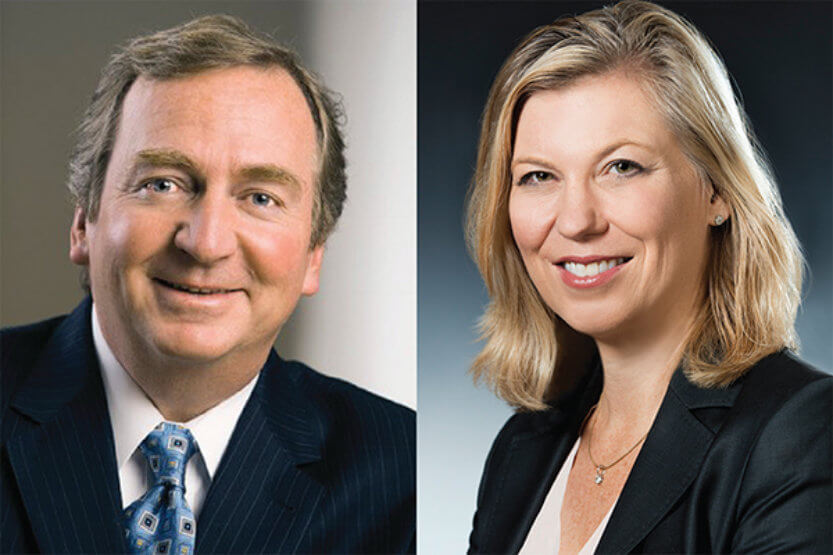
This year, the University of Illinois Alumni Association marks the 20th anniversary of its Illini Comeback Awards, a program that invites prominent and accomplished alumni back to campus during Homecoming Week to share their personal stories and professional experiences with students. Past recipients include Arte Johnson, ’49 MEDIA, an actor and comedian best remembered for his work on the TV comedy show Laugh-in; Professor Der-Tsai LEE, ’76 ENG, PHD ’78 ENG, president of China’s National Chung Hsing University and a leader in computational geometry; Lynn Morley Martin, ’60 LAS, U.S. Secretary of Labor and Illinois Representative for the 16th district; Michael Strautmanis, ’91 MEDIA, JD ’94, chief engagement officer for the Obama Foundation; and Beverly Washington, ’78 FAA, president and CEO of Chicago-based business consulting firm Image Factor.
This year’s Comeback Award recipients, John Graf, ’80 las, and Mary (Vest) Mason, ’90 LAS, were celebrated during Virtual Homecoming Week, Nov. 29–Dec. 5, 2020.
During his 40-year career in global insurance, John Graf has held senior leadership roles at AIG, American General and Conseco. Most recently, he served as chairman, president and CEO of Forethought Financial until its sale to Global Atlantic (where he continues to serve on Global Atlantic’s board of directors). In addition, he has served as a board member of insurance companies QBE and Everest RE. Currently, Graf manages the investment activities of Rambler Ventures, a strategic investor in small-to-midsize, privately owned businesses.
A resident of Houston, Graf is active in the philanthropic community, serving on the boards of the Houston and Nantucket Boys and Girls Clubs, Memorial Hermann Health System, and Cristo Rey Jesuit College Preparatory of Houston. John and his wife, Maureen, are the proud parents of two daughters.
As chief medical officer of corporate health initiatives at Centene Corporation, a St. Louis–based managed care enterprise, Dr. Mary Mason oversees award-winning clinical programs designed to improve quality and reduce medical costs in a managed Medicaid population. She also serves as director of the Centene Institute for Advanced Medical Education. Mason founded and leads the Little Medical School, an award-winning educational organization with offices in more than 60 locations around the world. The school reaches 500,000 children and encourages them to aspire to health-care careers while learning about their own health.
An active member in the St. Louis community, Mason serves on the national board of Parents as Teachers and the national council for Washington University’s Institute of Public Health; she received both her MBA and M.D. from Washington. Mason is president of Dr. Genie’s Kids Foundation, the Little Medical School’s program for children in underserved communities. She received a Washington University School of Medicine Alumni Achievement Award in 2019 and a Women in White Coats Hero Award in 2020.
Mason and her husband John, a general surgeon, have three children.
Comeback Award winners are selected annually by members of the Student Alumni Ambassadors and the UIAA Awards Committee. Nominations accepted online at uiaa.org/illini-comeback-nomination-criteria.—David Scott

